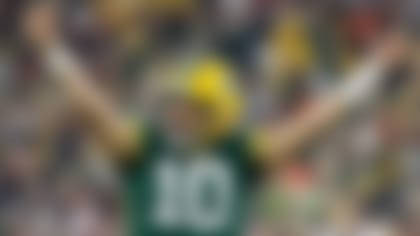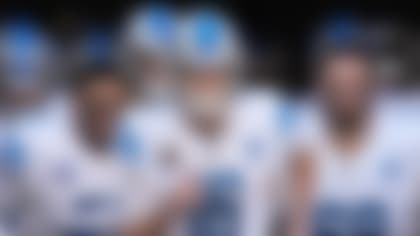Former NFL player and scout Bucky Brooks knows the ins and outs of this league, providing keen insight in his notebook. The topics of this edition include:
*-- Why Pete Carroll's a no-brainer pick for Coach of the Year. *
-- The blueprint Buffalo should replicate to maximize Josh Allen's abilities.
-- What Sean McVay must do to get the Rams firing on all cylinders again.
But first, a look at why the Giants definitely made the right decision in April ...
* * * **
I know it's not classy to say "I told you so," but ... I told you Saquon Barkley was the best player in the 2018 NFL Draft.
The New York Giants' rookie running back is not only as good as advertised -- he is arguably the most explosive offensive weapon in the NFL today. The 6-foot, 233-pounder has 100-plus scrimmage yards in 12 of his 13 NFL games and is on pace to tally 2,158 total scrimmage yards, which would make him just the third rookie in NFL history with 2,000-plus (Eric Dickerson had 2,212 in 1983; Edgerrin James had 2,139 in 1999). He comfortably leads all rookies with 78 catches, and currently ranks third among all NFL players with 1,124 rushing yards. If Barkley takes the rushing title -- he trails current leader Ezekiel Elliott by 138 yards -- he'll be the third rookie in a row to achieve the feat and the seventh since 1970.
Considering the numbers and the historical company Barkley's keeping in Year 1, it's safe to say Big Blue (5-8, but still not eliminated from the postseason) got it right in picking the running back over the available options at quarterback. By opting to take the "BPA" (best player available) at No. 2 overall, the Giants not only made their roster better in the short term, but they positioned themselves to build an offensive juggernaut in the very near future. To me, that's team-building at its finest -- and it's how championship squads are constructed in the salary cap era. Instead of reaching for a "project" at a position of need, it is better to take a blue-chip player to unquestionably enhance the overall talent on the roster. That's what I learned from legendary NFL executive Ron Wolf when I played for him as a member of the Green Bay Packers in the 1990s. The 2015 Pro Football Hall of Fame inductee told me you can never go wrong taking the best player available on draft day, and that adding good players to the roster will give a general manager enough options to acquire whatever he needs down the road.
"In my personal opinion, if you draft for need, that's when you get in trouble," McCloughan said in May of 2016, via the Washington Post. "All of a sudden you're like, 'Son of a gun, we had these three guys higher and they're going to the Pro Bowl, but we forced the issue to take that guy.'
"For me to do my job and make this organization as strong as it can be, I've got to take the best football players."
With that in mind, it is important to note that players selected at the top of the draft are expected to be generational talents capable of ranking within the top five of their positions early in their careers. This is the standard cited by many executives when considering prospects within the first five picks, and it was certainly the measuring stick used by Giants general manager Dave Gettleman when he was pondering his options at No. 2.
"Guys, this is the second pick in the draft," Gettleman said at a pre-draft press conference, via SNY. "We really have to picture this guy putting on a gold jacket."
Gettleman wanted a "gold jacket" guy -- i.e., the kind of Hall of Fame talent who has the capacity to turn around a franchise. Well, it's obviously still early, but Barkley's immediate production certainly suggests that he is on that kind of track. Thus, it appears New York's veteran talent evaluator got exactly the kind of impact player he desired.
Of course, the Giants still must address the quarterback situation to legitimately compete for a Super Bowl title in the coming years. Although Eli Manning is enjoying a bounce-back season -- thanks, in no small part, to Barkley's contributions as a runner/receiver -- the 37-year-old is nothing more than a mid-level starter (if that) at this stage of his career. The Giants need to identify the franchise's next QB1 ASAP, or risk wasting the prime years of their spectacular quartet of playmakers: Barkley, Odell Beckham Jr., Evan Engram and Sterling Shepard).
Looking at New York's current depth at the position, I don't really believe Kyle Lauletta or Alex Tanney is a future starter in the league. Although each player could serve as a longtime QB2 in the right situation, the Giants' explosive offensive talent demands a better option at the QB1 spot to compete for a Super Bowl title in 2019 and beyond.
Surveying the potential 2019 free-agent market, Teddy Bridgewater would appear to be a viable option, based on his experience with Giants head coach Pat Shurmur in Minnesota and his refined game. Although Bridgewater has some limitations as a deep-ball passer, he is an efficient "small ball" distributor adept at getting the ball into the hands of playmakers in space. Considering the Giants' offensive arsenal, Teddy could thrive as a QB1 in New York. If Derek Carr and Joe Flacco become available in the offseason, they could jump to the front of the line as talented QB1s with decent resumes -- but hefty price tags. New York could also target Tyrod Taylor or Trevor Siemian as a value-priced ex-starter with a limited game.
If the Giants look to the 2019 NFL Draft for QB help, they will find the market doesn't offer any sure things at the position. We'll have to wait and see if certain underclassmen throw their hat into the ring, but even the best of those prospects don't qualify as can't-miss guys, due to limited experience and rawness. The senior class features a host of intriguing options -- guys like West Virginia's Will Grier and Missouri's Drew Lock -- but the jury is still out on whether any of them are worthy of first-round consideration, based on their on-field performances throughout their collegiate careers.
Regardless of how the Giants choose to address the quarterback position this offseason, they've already put together an offensive lineup that ranks as one of the best units in football when it comes to perimeter weapons. If they can identify the right game manager to lead this group, the decision to opt for Barkley over a slew of QB projects this past April should continue to be viewed as the sensible choice for a team that can vault back into legit contention as early as next fall.
COACH OF THE YEAR: Why Pete Carroll should finally earn the honor
If the Coach of the Year award is based on merit instead of popularity, Pete Carroll should walk away with the honor in a landslide. Despite previously winning a Super Bowl and claiming back-to-back NFC championships, the 67-year-old is doing his best coaching job yet with a cast of newbies, misfits and holdovers on a team that, back in August, was widely expected to vie for the No. 1 overall pick.
With Seattle thriving despite a pair of new coordinators and a number of new assistants, Carroll deserves a standing ovation for conducting an "on the fly" rebuild without taking a step back as a playoff contender.
Studying the Seahawks throughout the season, I've been impressed with the team's commitment to playing a style that best suits its personnel. Instead of trying to win games with a pass-first premise built around the franchise quarterback, Seattle is using an old-school model featuring a hard-hitting defense and punishing running game. Although the Seahawks' vintage teams were built on this philosophy, the 2017 version of the 'Hawks deviated from this approach, and Carroll headed into last offseason intent on getting back to basics with a revamped roster and coaching staff.
Now riding high at 8-5, Seattle currently fields the fourth-youngest roster in the NFC (average age: 26 years and 113 days). The youth movement has not only enabled Carroll to rebuild the team in his vision -- with extreme competitiveness as the primary objective -- but it has helped the Seahawks get back to constructing a true team, one that relies on every unit and player complementing each other. And this is exactly what Carroll envisioned, whether you believed him at the time or not, during this past offseason.
"It's pretty plain to see, that when guys have established themselves for four or five or six years at a spot, and they've been really effective at what they do, it's hard to convince the next guy that he's going to take their spot," Carroll told The MMQB over the summer. "That's for sure. So, when opportunities are more open, it does create, in the truest sense, the best connection to what the philosophy and the approach is all about.
"And it feels like four or five years ago. It feels fresh and wide open, it's more of an open competition for some of the spots. And that's a really good thing for us, because it does feed into the whole approach."
This is precisely how Carroll built Seattle into the NFC's biggest bully earlier in the decade -- going 56-23-1 with three division titles from 2012 through 2016 -- and it is beginning to look like he's doing it again.
In Ken Norton Jr.'s first year as Seahawks defensive coordinator, Seattle ranks among the top 10 in scoring defense (sixth), takeaways (tied for eighth), third-down percentage (fifth) and red-zone D (ninth). This is quite impressive, considering the unit lost Richard Sherman, Kam Chancellor, Michael Bennett, Cliff Avril and Sheldon Richardson during the offseason, while Earl Thomas went on injured reserve in early October. Those six players have 19 combined Pro Bowl appearances to their names.
Stop and think about that for a second. A unit led by a coach (Norton) considered a flop after getting fired by the Raiders one year ago has played solid football with a new cast of characters slotted in key roles. Although Bobby Wagner and Frank Clark have stepped in as leaders, the defense is loaded with a bunch of inexperienced playmakers and former reserves maximizing their opportunities on the field. To me, that's a sign of great coaching and player development, which points back to Carroll and the work that he's done with everyone in the building.
Offensively, Seattle has gone against the grain with a run-first attack that bludgeons opponents behind a three-headed monster at running back. The Seahawks not only comfortably lead the NFL in rushing yards per game (153.8), but they are the only team with 2,000 rushing yards (on the dot -- the Panthers are second with 1,786) and remain the only squad with a run percentage of 50 percent or better (52.3). The 'Hawks are committed to pounding the rock between the tackles and they refuse to relent when things don't go their way early in games.
Considering the Seahawks' woeful run-pass balance during the first two weeks of the season -- when Russell Wilson had 69 pass attempts compared to the team's 38 rushes and Seattle started 0-2 -- the radical shift speaks volumes about Carroll's understanding of his personnel and his willingness to adapt and put his team in the best position to win.
"We were close enough we could have done whatever we wanted to all the way down to the end of it. I just got a little bit impatient, threw the ball a bit more than we needed to," Carroll said back in September, taking blame for the pass-run disparity. "And so you look back and that's with limited opportunities because we weren't converting, it just kind of works together. I'm just owning up. But that's what I would say is the issue with that. I need to be a little less impatient. I'm a little bit, tend to be that way, you know?"
With that in mind, Carroll's influence on offensive coordinator Brian Schottenheimer shouldn't go overlooked. The defensive-minded head coach has coaxed his new play caller into leaning on the running game with every back playing a key role. The Seahawks are the only team in the NFL with three running backs boasting 400-plus rushing yards (Chris Carson, 794; Mike Davis, 418; rookie Rashaad Penny, 413) and could become the first team since the 2004 Kansas Chiefs with three guys topping 500 rushing yards.
Considering the creativity of Seattle's running game, with six offensive linemen routinely on the field to create a physical and numerical advantage at the point of attack, the Seahawks' coaching staff deserves credit for their flexibility and imagination in an area that's widely underappreciated in today's NFL.
The Seahawks have also embraced a commitment to ball security, with the fewest giveaways (10) in the NFL and a turnover differential (plus-11) that ranks second. Given the correlation between the turnover battle and game outcomes, the decision by Carroll to opt for a more conservative offensive approach despite having a top-tier quarterback in the fold is another example of the wily coach putting team success over ego and individual stats.
It's pretty surprising that Carroll has never earned Coach of the Year before. But if this award is really supposed to go to the leader doing the best coaching job in the league, Carroll should win in a landslide.
TWO-POINT CONVERSION: Quick takes on developments across the NFL
1) All aboard the Josh Allen Experience? OK, it's definitely too premature to be comparing the Bills rookie quarterback to Michael Vick in any capacity -- as in, alluding to the former dual-threat playmaker's memorable Nike commercial. That said, it is time to view Allen as a unique talent at the position with an unorthodox game that can produce positive results.
Now, I will be the first to admit to being critical of the Wyoming product during the pre-draft process -- his scattershot accuracy was quite concerning -- but I did believe he could be a Cam Newton-like playmaker with a unique game that a team could build an offense around. When Buffalo selected Allen seventh overall, I immediately thought of Bills head coach Sean McDermott and general manager Brandon Beane, and how they'd both been in Carolina for Newton's MVP season that ended in the Super Bowl.
Then I saw Allen's second NFL start in Week 3, when he accounted for 235 yards of total offense and three scores in a 27-6 upset win at Minnesota. The shocking performance gave the football world a glimpse at Allen's talent and potential in an offense that's tailor-made for his skills as a mobile playmaker with A-plus arm talent.
Studying the All-22 Coaches Film from that stunning win over the Vikings, I noted that the Bills used a variety of designed QB runs and zone-read concepts to showcase Allen's talent as a runner. The 6-foot-5, 237-pound quarterback bedeviled Mike Zimmer's defense with his combination of skills as a run-pass threat at the position. From his quick-rhythm completions on screens to his teardrop-like deep balls to his impromptu scrambles, Allen terrorized the Vikings as a mobile playmaker. Although it wasn't always pretty, it was effective. And the Bills' coaching staff certainly flashed enough creativity to build a dynamic offense that would help the rookie play to his strengths as a runner and deep-ball thrower. That said, it was apparent Allen was still a work in progress as a QB1 and his coaches would need to find a way to minimize his weaknesses to give Buffalo a chance to win games.
After watching Allen become the first quarterback to rush for 100-plus yards in back-to-back games while surpassing Vick as the quarterback with the most rushing yards in a three-game span (335 yards from Week 12-14), I had to go back to the tape to check out No. 17's evolution over the course of his first NFL season. Before I really dug in, though, I took a look at Allen's numbers and was shocked by his inefficiencies as a passer. Allen ranks last among qualifying quarterbacks in completion percentage (52.4), pass yards per game (169.4), touchdown-to-interception ratio (5:9) and passer rating (63.3). He also ranks 31st in yards per attempt (6.3). Those numbers are not inspiring, to say the least, but Allen was expected to struggle as a rookie starter, especially given Buffalo's suspect receiving corps. The Bills not only lack a legitimate WR1, but the team doesn't have an established complementary playmaker outside of Charles Clay and maybe Zay Jones. To his credit, Allen has shown glimpses of being an effective passer between the numbers on intermediate routes like curls and digs. He also flashes enough arm strength to make "wow" throws on the move, which makes him a dangerous player.
From a critical standpoint, Allen is a streaky passer from the pocket prone to long stretches of misfires. The 22-year-old inexplicably misses open receivers at every distance, routinely failing to connect on vertical throws. The misfires certainly disrupt the rhythm and flow of drives, particularly when No. 17 short hops a lay-up designed to pad his stats and put the Bills in a manageable down-and-distance situation. Kinda sounds like Cam, huh? That's why I believe Allen should be graded on a curve like other dual-threat quarterbacks, including Lamar Jackson and Newton. Like his counterparts, Allen's running skills are an integral part of the game plan, with his rushing yards factored into his total impact as an offensive weapon.
Although most of Allen's production as a runner has been accumulated on impromptu scrambles from the pocket, he has displayed the ability to be a difference maker on designed QB runs and zone-read plays, particularly in short-yardage and goal-line situations. With his combination of athleticism and mobility, Allen's a dangerous threat on the perimeter, which makes option plays more difficult to defend at the line of scrimmage. Considering the Bills' lack of weapons, the utilization of Allen as a dual-threat is sensible for a team desperately seeking more explosive plays.
Looking at Allen's situation and overall impact on the Bills' offense as a dual-threat, I can't help but think of how the Panthers fully leaned on Newton's unique talents to elevate the offense early in his career. I'm not trying to suggest Allen has clear MVP potential at this point, but he has already shown the football world that he can win games as a run-first playmaker on the perimeter. Sure, it is not the ideal way to play quarterback in this league, but Newton's success despite his erratic moments as a passer provides a blueprint for the Bills.
If the Bills can build a passing game that features isolation routes (slants, quick outs, skinny posts and comebacks) outside the numbers with some basic play-action passing concepts (post/dig/shallow cross) over the middle, Allen can become a competent passer with the capacity to succeed despite a low completion rate. Now, in order to enhance Allen's game, I would advise the Bills to add a speed receiver (vertical threat) and a big-body pass catcher (possession receiver) to the lineup this offseason.
In the running game, Buffalo would be wise to steal some of the designed quarterback runs and option plays the Panthers have used in the past with Newton, thus making Allen a more dangerous weapon in the backfield, particularly in third-down, short-yardage and goal-line packages. Considering Allen's success running quarterback powers and sweeps near the goal line as a rookie, it's a move that could pay huge dividends for the Bills.
Allen's unprecedented success as a runner has drawn comparisons to Michael Vick, but the rookie playmaker has really given McDermott and Co. a Cam-like QB1 to build around.
2) Will Sean McVay learn his lesson? I have the utmost respect for the Rams' wunderkind head coach as a team builder and play caller, but I wonder whether McVay will truly absorb the lessons from the Rams' 15-6 loss in Chicago to help him build an effective offensive strategy against elite teams that results in a Super Bowl run.
"I've got to be better for our football team, but this loss is on me," McVay said after the game. "I didn't do nearly a good enough job for us today and I trust that we'll respond the right way."
There's no sugarcoating it: The Rams' offensive architect has to improve down the stretch to help his team reach the winner's circle in a competitive conference tournament that not only will feature another high-powered offense (New Orleans), but could present a bevy of suffocating defenses (Chicago, Dallas, Seattle, Minnesota) with the potential to transform any playoff game into a grind-it-out affair. With defensive coaches honing in on McVay's tendencies and building comprehensive scouting reports on his top players, the creative play caller has to stay true to the Rams' identity and avoid getting caught up in a "show and tell" contest where he showcases exotic plays to simply elicit standing ovations and applause from the All-22 tape-watching crowd.
Now, that's not a dig at McVay. He's built one of the most dynamic and innovative offensive schemes that we've seen in recent history. But every coach has an ego, and he must resist the temptation to "wow" observers with his play calls instead of getting the ball to his best player to properly set the table for the rest of his offensive weapons.
Quite simply, McVay needs to make sure Todd Gurley is the focal point of every week's offensive game plan.
"Gurley is the straw that stirs the drink for the Rams," a former NFL defensive coordinator told me. "He is the only star on their offense, and every defensive coordinator enters the game intent on slowing him down. ... If McVay doesn't use him, he lets the defense off the hook and the Rams are much easier to defend."
To that point, Los Angeles is clearly more effective when Gurley touches the ball early and often. Since 2017, the Rams are 20-2 when No. 30 finishes with 15 or more carries in a game. In those 22 games, the offense has scored 32.6 points per outing, with Gurley averaging 97.7 rush yards and 147.6 scrimmage yards with 35 total touchdowns.
By comparison, the Rams are just 2-4 in this same time span when Gurley finishes with fewer than 15 carries in a game. The team's scoring average dips to 28.8 points per, with Gurley averaging just 59.7 rush yards and 92.0 scrimmage yards. Considering Gurley only totaled three scrimmage touchdowns in those six games, it is apparent his impact is minimized when he takes a back seat on the call sheet.
"Great offensive coordinators make you stop their guys," the former NFL defensive coordinator said. "If McVay doesn't give the ball to No. 30, he's stopping himself. He needs to make defenses prove that they can stop Gurley before giving the ball to the other players.
"It's really that simple: Run the game through No. 30 and let everyone else fall in line after that."
Those comments might surprise some observers, but the NFL really is a simple league in this sense: The best players dictate team outcomes. Despite the notion that Jared Goff has blossomed into a top-level quarterback, the Rams remain a team reliant on the play of its RB1. Look no further than Los Angeles' last two games for proof. Since Week 13, Goff has posted a 48.1 percent completion rate while averaging just 193.5 passing yards on a paltry 5.0 yards per attempt. With the third-year pro compiling a 1:5 TD-to-INT ratio and 40.3 passer rating during this span, it is fair to question whether Goff is capable of carrying his team when the offense operates as a pass-first unit without Gurley heavily featured in the plan.
Remember, Goff led the NFL in passing yards off play-action in 2017 and he remains a quarterback who is most effective throwing off run-action this season, as evidenced by his 110.4 passer rating on play-action passes. Although play-action can be at least somewhat effective regardless of whether a team's running game is productive, the mix of Gurley runs and play-action passes will certainly impact opposing defenses on the second level, with linebackers and safeties focused on controlling the All-Pro back to diffuse the Rams' high-powered attack.
The Rams' perimeter playmakers need Gurley to be a factor in the game plan to help them get going on the outside. Sure, Brandin Cooks and Robert Woods are one of only three duos with 1,000 yards a piece (Tyreek Hill/Travis Kelce and Antonio Brown/JuJu Smith-Schuster are the others), but neither guy is considered a true No. 1 receiver with the capacity to dictate coverage through his presence and production on the perimeter. Defensive coordinators will take their chances in single coverage against Cooks and Woods, committing an extra defender to the box to contain Gurley. However, if the Rams don't feature the back enough as a runner and receiver, opponents will use more two-deep or split-safety coverages to take away the big plays and force Goff to play "small ball" from the pocket.
It's hard to knock McVay while he's directing an offense that's putting up 32.7 points and 422.5 yards per game, but the Rams suddenly look like a more vulnerable squad after being throttled by the ferocious Bears defense -- one week after a pretty uninspired performance in Detroit. With the competition poised to tick up in the postseason, we will soon find out if the 32-year-old head coach can re-balance his game plan for the better and guide L.A. to Atlanta for Super Bowl LIII.
Follow Bucky Brooks on Twitter @BuckyBrooks.













